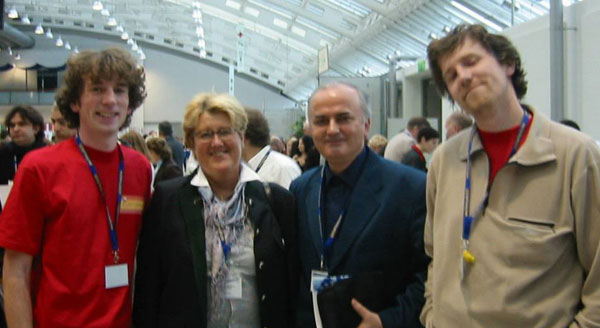Discussing several aspects of intercultural computer-mediated communication (ICCMC) Amant (2002) explains what happens “when cultures and computers collide”. He argues that some computer-mediated communication (CMC) aspects appear to go against the communication needs and anticipations of cultural groups, particularly in relation to the online identity of users and their needs to set up attitudes.

With a group of teachers who attended my workshop on “Bridging cultures through computer-mediated communication projects”, in Linz, Austria, 2006
He concludes that scholars should compare CMC and ICC trends mentioned in the referential literature to see to what extent they have common points and which aspects differentiate them. Identifying adequate communication strategies in ICCMC would minimise shifting the intercultural online discourse due to the changeable online identity of the users.
Amant states (2002, p. 199) that ICC and CMC conflict in a number of points:
- ICCMC reduces human interaction to words, because CMC is faceless, lacking nonverbal cues
- The ICCMC allows computer software to “masquerade” as human beings
- CMC allows authorship modification; “the sender identity is often blurred by the reposting of electronic message” (p. 199, citing Warnick, 1998) because cutting and reposting someone’s message is common in an online context
- The “plastic identity” (changeable identity) of the online users may conflict with the communication norms in certain cultures
- Use of humour and ostentatious behaviour when creating online ethos (attitudes, habits and beliefs characterising an individual or groups of individuals) may generate misunderstanding when partners from other cultures perceive things differently
- People whose native language is not English may a have different level of understanding of messages conveying irony, sarcasm and cynicism
- Silence in ICCMC may be perceived differently by individuals representing different cultures; people who seem more silent or passive could be seen as “less important” versus active participants.
Even though technology eliminates traditional communication obstacles of distance and time, it may intensify cultural rhetorical differences and damage relationships, as the author stresses (p. 197): “Intercultural online communication needs to be thoroughly evaluated to avoid potentially costly mistakes in the international online environment”.
As the access to ICCMC depends on technology availability, and because its future use will certainly increase, ICCMC may have major implications on the online exchange involving people from different cultures. This happens because of the contrast between face-to-face ICC and ICCMC, notably in terms of identity and ethos construct.
Intercultural computer-mediated communication has considerably changed some concepts that were previously associated to face-to-face ICC. It is obvious that not all the principles of face-to-face ICC apply in an online context. But in both situations a successful ICC entails awareness of cultural norms and values from other cultures.
Due to the lack of contextual cues, computer-mediated communication may hide people’s attributes, such as age, gender, race, physical disability etc. In other words, CMC may reduce stereotypical behaviour in a virtual context, as Gragert (1999, online) emphasises “For the first time, the content of what a person writes is conveyed without the visual packaging of gender, race, age, or national origin, which can and do influence how people receive the information.”
Over the past years, research has paid attention to intercultural computer-mediated communication, studying the context and skills needed to understand people from other cultures, and therefore how cultures influence communication and perception of the world. Even if some theorists argue that globalisation might be a threat to local cultural identities, getting to know other cultures increases the chances of understanding them and therefore minimising intercultural misunderstanding.
References
Amant K. St., (2002), “When Cultures and Computers Collide: Rethinking Computer-Mediated Communication according to International and Intercultural Communication Expectations”, in Journal of Business and Technical Communication, Vol. 16, NO. 2 April 2002, pp. 196-214, Sage Publications
Gragert E., (1999), The Internet Potential for an Education of Hope, [online], [accessed March 2014]

This reminds me of my Cross-Cultural Communication course! (try to say that 3 times fast!) 😀
🙂